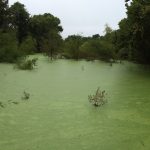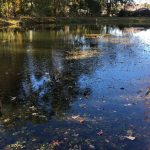
Louisiana 4-H Compound Archery Team place nationally!
July 3, 2022Public health notice: LDH notifies public of updated EPA drinking water advisories
July 5, 2022During the summer months, it is not unusual to see the surfaces of ponds, lakes, bayous and other stagnant or still bodies of water covered with a green layer (Figures 1, 2 and 3). This layer is composed of various aquatic weeds and algal species. These algal blooms can cause substantial environmental and health care issues and economic losses throughout the U.S. These algal blooms can also be used as valuable indicators for environmental quality and ecosystem conditions. Control of these blooms is always troublesome because of changes in species composition and the wide range of water conditions in which algae can survive.
Some harmful algal blooms (HABs) release toxins that are dangerous to humans and animals. An example would be algal blooms composed of phytoplankton that are known to naturally produce biotoxins that are harmful to plant and animal species. Some algal blooms are actually composed of both bacteria and plant species. Blue-green algae are among the most commonly reported HABs, but they are actually bacteria with a prokaryotic cell structure. Blue-green algae also have chlorophyll-a, a photopigment characteristic of eukaryotic algae and higher plants. Structurally, blue-green algae are bacteria-like, but functionally they are more algae-like. Because of this photosynthetic functionality, blue-green algae are typically sampled and analyzed as part of phytoplankton (algal) groups rather than bacterial groups in aquatic ecosystems. Blue-green algae produce a class of acutely toxic compounds called microcystins. Because of the acute toxicity and potential carcinogenicity of microcystins to animals and humans, there are concerns about human and domesticated animal exposure via lake and reservoir systems. Excessive aquatic weeds and algae growing on the water surface are capable of depleting oxygen in the water column and blocking sunlight that other aquatic organisms require to survive.
Proliferation of algal blooms
Algal blooms are often the result of excessive nutrient releases into water bodies from agricultural practices and other human activities. Key pollution sources that influence outbreaks of weeds and algae include, but are not limited to, daily household activities, gardening, agriculture, forestry and land development, as well as septic and other waste treatment systems. Lakes, reservoirs, rivers, streams and ponds that receive these sources of pollution either periodically or regularly are capable of producing high densities of unwanted vegetative growth. Blooms eventually result in eutrophication and hypoxia. Eutrophication is caused by an overabundance of nutrients in the water body that promote excessive growth of algae and aquatic plants. Eutrophication can lead to hypoxia or dead zones because of the depletion of oxygen in the water, which may result in fish kills. Hot, calm conditions are ideal for HABs. Excessive aquatic weed and algae growth can decrease the aesthetic value of an aquatic ecosystem and negatively impact their use for fishing, swimming, boating or other recreational activities.
Management of blue-green algae
It is important to note that not all aquatic plants and weeds are problematic or result in unhealthy conditions. The value of vegetation in and around ponds is important to our aquatic environments, particularly for those inhabited by fish, wildlife, and invertebrates; however, exposure to any blue-green algae blooms can cause health effects in people and animals when contaminated water is touched or swallowed or when airborne droplets are inhaled. Exposure to high levels of blue-green algae and their toxins can cause diarrhea; nausea or vomiting; irritation to skin, eye or throat; and allergic reactions or breathing difficulties. Algae prevention is typically easier than algal removal after establishment. There are two best management strategies for prevention of an algal bloom, including the reduction of fertilizer runoff and the amount of silt entering into your pond. An additional management option is to maintain a grass buffer strip around your pond, which aids in the interception of soil particles and nutrients that wash off from surrounding fields or lawns.
The most common and versatile management strategy is the use of aquatic herbicides. In comparison to mechanical control, herbicides provide longer control, are less labor-intensive, provide flexibility and predictability, and are generally cost-effective. If conducted under ideal conditions and the product label is followed, the application of algaecides and aquatic herbicides will have minimal effects on the the ecological balance, and several of the products have relatively short half-lives (hours to days).
One disadvantage of chemical control is the potential for depletion of dissolved oxygen when large quantities of submerged aquatic vegetation are rapidly killed or plant material is rapidly decomposed. A rapid decrease in oxygen can result in a fish kill, particularly in small aquatic systems such as ponds. If the pond is heavily infested with weeds, no more than half of the water body can be treated with a contact (fast-acting) herbicide at one time. Treat the pond in sections and allow each section to decompose for approximately two weeks before chemically treating another section. Aeration, particularly at night, for several days after treatment may help prevent oxygen depletion. Slow-acting systemic herbicides can be administered in a single application throughout the entire water body because plant control is slow and fish kills from a rapid decrease in oxygen are less likely to occur.
How do I know if I am being exposed to blue-green algae?
If the water is noticeably discolored or is covered with a surface scum, your pond may contain harmful blue-green algae. The water is typically a shade of green, blue-green, yellowish-green, brown or purple. The water should not be tested by taste or smell.
What should I do if I suspect a bloom?
- If you identify a suspicious algae bloom, you should avoid skin contact.
- Pets or livestock should avoid contact with water affected by these blooms or surface scums.
- Humans or pets and livestock should not consume untreated surface water. Although water in your home is filtered or treated with chlorine or ultraviolet (UV) light, the treatment may not be sufficient to protect you from blue-green algal toxins.
Changyoon Jeong, Ph.D., Assistant Professor of Soil and Water Management, School of Plant, Environmental and Soil Sciences, Red River Research Station, LSU AgCenter, Bossier City, LA 71112.
Email: cjeong@agcenter.lsu.edu











